Election Day 2025: TV5 shines with live data reporting
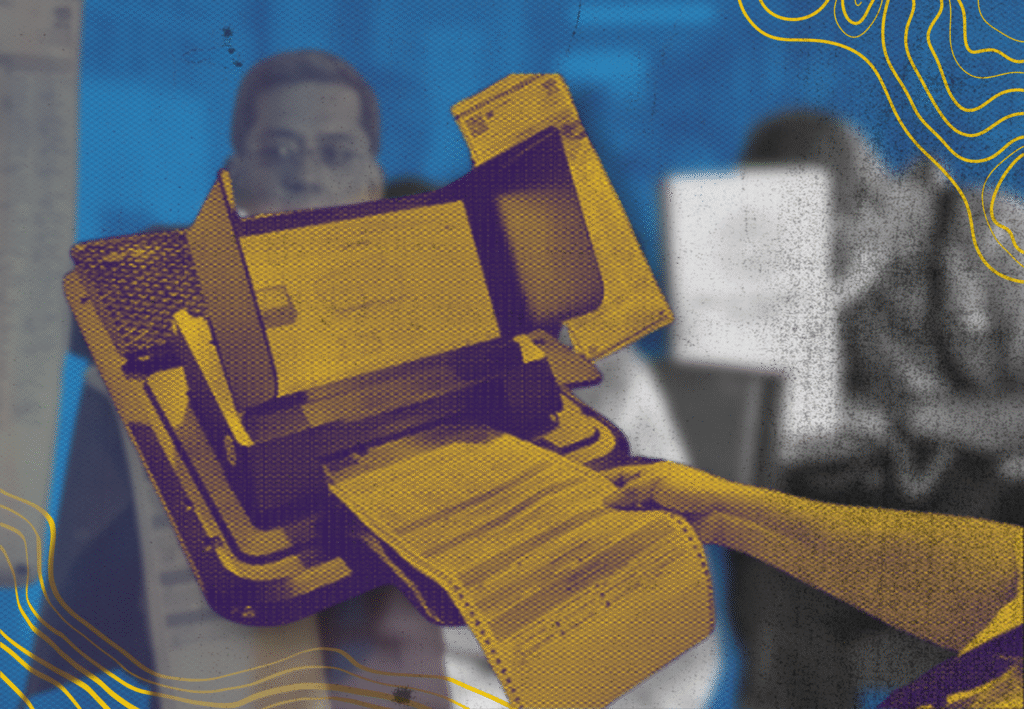
MEDIA HIGHLIGHTED the violence and mechanical disruptions in the coverage of the 2025 midterm elections on May 12, which were held amid significant political developments, including the falling out between the president and vice president.
The feud broke down the unity alliance platform that catapulted the Duterte and Marcos families to national leadership. In the three years since their electoral triumph, Ferdinand Marcos Jr. and Sara Duterte parted ways, leaving their respective supporters to quickly scramble for endorsements for their individual victories.
Media reports did not delve into this broader political context on election day. Midterm elections are rarely seen as exciting or as critical as presidential elections. News accounts did not dive deep to analyze the vote as a referendum on the Marcos Jr.’s administration, his policies and programs. Instead, coverage focused more on the surprising turnout that included two independent candidates, Benigno “Bam” Aquino IV and Francis “Kiko” Pangilinan—both of whom had not been included in the winning slates projected by public opinion surveys.
CMFR monitored the coverage of the top three TV networks with a nationwide reach (ABS-CBN on Kapamilya Channel, GMA-7, TV5) on May 12 and 13.
The three channels ran marathon coverage from election day to the following day, each allocating more than 30 hours of airtime to the special broadcast. Both GMA-7 and TV5 started their special coverage at 4 am on May 12; ABS-CBN at 5 am, in time for the two-hour window for senior citizens and persons with disabilities.
TV5 signed off at 2 am, May 13; resumed broadcast at 5 am and ended its special coverage at 11 am. ABS-CBN and GMA-7 had no sign off, ending their election broadcasts at 12 noon of May 13.
Production notes
TV proved its staying power, feeding live reports from all over the country and from studio where anchors received updates from precincts, discussed the results with experts and resource persons, and tracked big and small problems encountered by voters.
All three networks called on their correspondents in the provinces. GMA-7 however deployed the most number of reporters to cover all three island groups, presenting the most “national” electoral coverage.
TV sustained discussion through guest panels and used interviews to fill up the time segments throughout the day until late at night. Coverage after voting hours shifted to analysis, mostly with talking heads interpreting the meaning or message carried by people’s selection of the magic twelve.
Production values
ABS-CBN and GMA-7 seated guests on the same table as anchors. TV5 seated their guests on a couch some distance from the anchors, with rather mixed results. Clearly, they had more ample space but the visual effect was awkward, drawing a visual line that did not enhance the exchange.
GMA-7 highlighted the projection of 3D graphics, with dynamic visual projection of candidates and other election-related data.
TV5 retained the panoramic screen used in the network’s coverage in the past, utilized for visual presentation of pre-election survey results and emerging trends and patterns during the day, including partial and unofficial count for the senatorial race.
ABS-CBN’s setup relied on the simple studio layout, setting aside space for updates provided by standing anchors. It was the only newsroom that showed the “war room” with support staff at work.
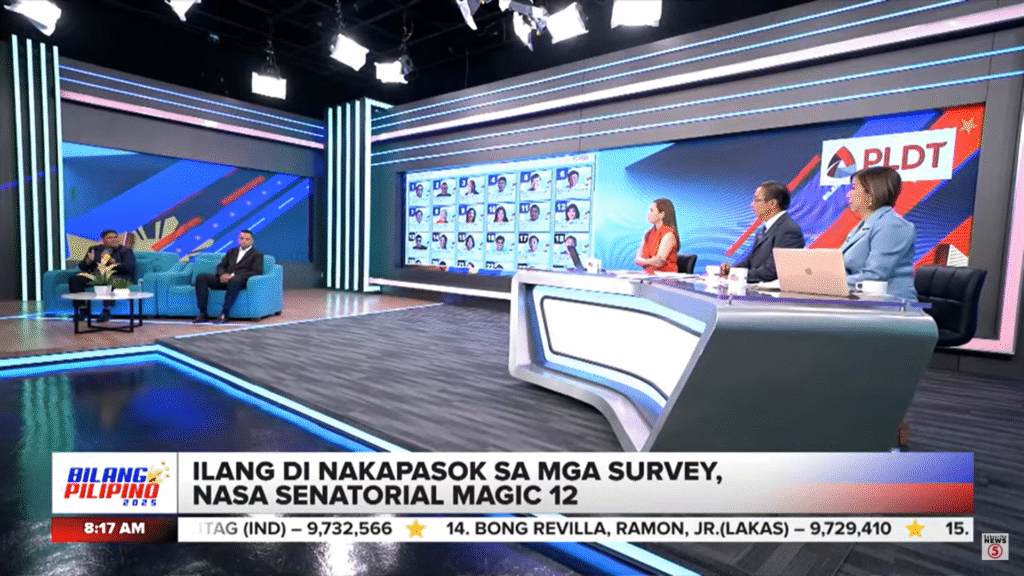

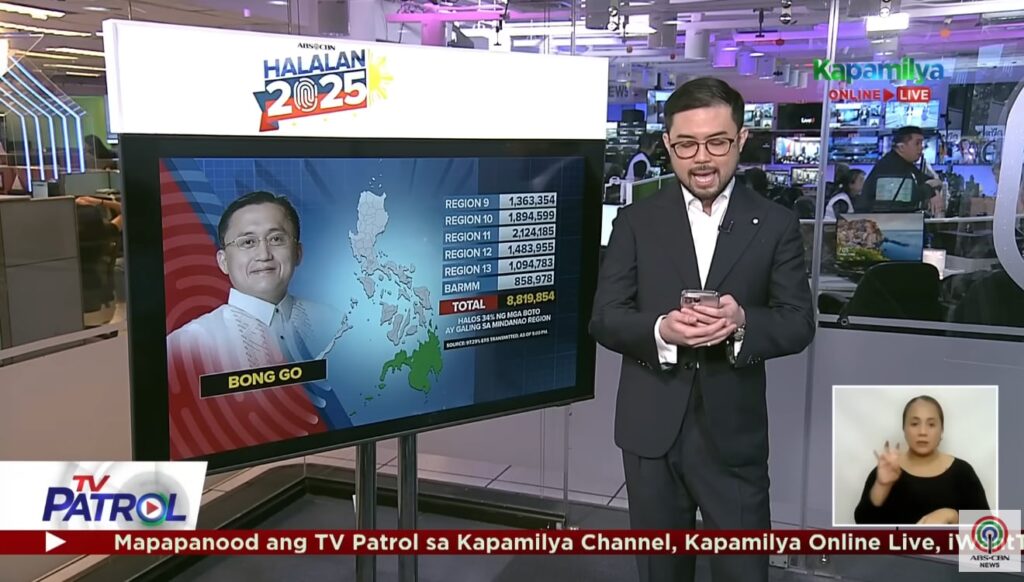
All three news outfits featured online livestreams and websites for easier tracking of election results. Users could zoom in on their locality to check on the number of votes as these were transmitted through the Comelec media server.
Heat maps were used to present the progress of votes in a particular province, city or municipality. GMA-7’s site allowed users to check voting trends down to the barangay level nationwide.
Same old problems
Throughout the day, reports from the field pointed to the usual problems that have hounded the past five automated elections. Across the country, reports showed up voter complaints about missing names in voter lists; malfunctioning automated counting machines (ACMs); ballot rejections due to ink smudges; invalidated ballots due to over-voting or shading beyond the maximum number of candidates that can be elected for a certain position; and complaints about supposed inaccuracies in receipts.
Media reported that President Ferdinand Marcos, Jr. himself, who was at his precinct in Ilocos Norte at 7 am, encountered a minor glitch as his ballot was rejected the first time he fed it to the machine. It was accepted on his second try.
It was telling that no available spokesperson or tech expert from Miru Systems, the manufacturer of ACMs, could have addressed the technical issues publicly. Anchors and reporters did not say whether they tried to reach out to Miru to get some answers. Some field reporters did note that there were technicians on standby for some precincts, but none of them were interviewed.
Sitting as in-studio guest in the 2 pm segment of GMA-7’s special coverage, Lito Averia, chair of the National Movement for Free Elections (Namfrel) said the machines’ performance could have been affected by the warm temperature in classrooms. Averia recalled that the same machines were tested in air-conditioned warehouses under a more ideal environment.
Field reporters noted that the problematic ACMs were replaced more quickly this time, as compared to the experience with the Smartmatic-manufactured vote counting machines (VCMs) in the 2022 elections.
There was no need to extend voting hours except in Datu Odin Sinsuat, Maguindanao del Norte, where protests and a blockade by a political party caused a 10-hour delay in voting.
George Erwin Garcia, chair of the Commission on Elections (Comelec), acknowledged the temperature factor in a press briefing held at 6 pm on May 12, saying humidity could have affected ink quality and the sensitivity of the ACMs’ scanners. Garcia reported that only 311 of the 16,000 contingency ACMs were used as replacement machines—a low number compared to the more than 2,000 faulty VCMs in 2022. He also stressed in the briefing that these issues did not disrupt voting. There was no failure of elections in any area, as machines and election materials were all delivered and electoral members expected to report for duty all arrived.
The statement did not provoke media questions about the lack of action to address the heat factor, as elections are held at the height of summer. Media should take note and include climate-proofing the elections in the news agenda.
Acknowledging the improvements in the automated voting process, two election watchdog groups, Namfrel and the Legal Network for Truthful Elections did issue a call for Comelec to be more more transparent in explaining malfunctions, and to discuss how these can be addressed and avoided in the future.
At the end of the day
ABS-CBN and GMA-7 aired their regular primetime newscasts TV Patrol and 24 Oras at 6:30 pm. TV5 opted to keep its special programming in lieu of Frontline Pilipinas that usually airs at 6 pm. All three channels showed footage of people still lined up in precincts to cast their vote close to the 7 pm deadline. TV Patrol and 24 Oras reviewed malfunctions and other election-related incidents in voting precincts which had been reported earlier in the day.
Shortly after 7 pm, coverage started reporting election returns transmitted from precincts. Anchors duly noted that these were not the total number of votes received by a candidate.
By 8 pm, media reported that the transparency servers of the media, majority and minority parties, and poll watchdogs still had not received tallies, prompting some to recall the transmission delays experienced in 2022. The partial and unofficial results started coming in by 8:30 pm, and was on all TV screens by 9 pm.
Garcia later told the media that the data from Comelec’s primary server is transmitted simultaneously to all accredited recipients. The differences that arise may be due to the programs and systems used by the stakeholders to process and display the data.
There was also no IT expert affiliated with Comelec who could have given a more detailed explanation than Garcia’s.
Surveys and the surprise vote
The three newsrooms were one in focusing on the surprise inclusion of senatorial candidates Bam Aquino and Kiko Pangilinan in the Magic 12, who were excluded from winners lists of public opinion surveys. How and why the surveys got it wrong fueled the exchange from the initial transmission of still unofficial results until the following day. For the first time, the two leading polling organizations acknowledged the need for review.
Explanatory points included the nature of the public opinion polls as mere snapshots of public sentiment at certain periods of time; and that these can change quickly. Mahar Mangahas, chairman emeritus of Social Weather Stations (SWS), told GMA-7 anchors that the sampling size has adhered to the same science that has been used from the beginning. He noted, however, that for the next polls, asking more questions might offer more insight into survey results, including asking when voters decide with finality who they are voting for.
Speaking to ABS-CBN anchors, Ronald Holmes, President of Pulse Asia, acknowledged the effect of socio-political events on voter decision. But he also said that given the results of the elections, Pulse Asia would look into a review of its “methodology.”
Prof. Froilan Calilung of the UST Political Science Department told TV5 that last-minute endorsements might have affected voters’ decisions. Dr. Philip Arnold Tuaño, dean of the Ateneo School of Government, told GMA-7 that the local alliances of national candidates also played a role in shaping voter preference.
Calilung emphasized that the midterm polls did serve as a referendum on President Marcos’s administration, as the results reflected the low trust and satisfaction ratings expressed in surveys of public opinion. Only five from the Alyansa slate endorsed by the president made it to the top 12.
In separate interviews on TV5, Prof. Eric Daniel de Torres of the UE Political Science department and Prof. Reginald Uggadan of the UP National College of Public Administration said the results reflected a public sentiment that incumbency and popularity are no longer enough for a candidate to win, citing the losses of Senator Ramon Revilla Jr., Willie Revillame and Ben Tulfo.
Prof. Julio Teehankee of the De La Salle University told ABS-CBN anchors that the midterm polls is the “surprise of 2025.” He noted that, “This is an amazing win for the yellow-pink party after three consecutive electoral cycles of loss.”
Youth vote
Anchors and guests also called attention to emergence of the youth vote as the number of voters swelled from their ranks. Prof. Edna Co of the UP NCPAG told GMA-7 anchors that the surveys might not have been able to capture the youth’s sentiment.
ABS-CBN stood out for having an actual representative of the youth to provide insight. Theo Abuan, engagement and outreach coordinator of the network Youth Vote Philippines was interviewed past 12 midnight on May 1, and talked about the impact of misinformation, not just on older citizens who might be less tech-savvy but even on the youth. He added that mainstream and legacy media remain relevant, as journalists are trained to verify information they present as news. Abuan reminded viewers that democratic exercise and civic engagement should not end with elections.
In separate interviews in GMA-7 and TV5 in the morning of May 13, Ronald Holmes, president of Pulse Asia, and Jean Franco, professor at the UP Diliman Political Science department, agreed that it would be difficult to determine the force of a youth vote. The lack of exit polls, both lamented, made it difficult to determine the demographic basis, if any, of the vote.
VP’s impeachment, Duterte’s influence
The impeachment of Vice President Sara Duterte was also a common topic across the three newsrooms. Anchors listed the political alliances of the Magic 12, noting the possible effect of the results on the impeachment trial.
Analysts agreed that the Dutertes remain influential and a force to be reckoned with, given the wins of former President Rodrigo Duterte and his son Sebastian Duterte in Davao City. Edmund Tayao, president of the consultancy Political Economic Elemental Research & Strategies, told ABS-CBN anchors that maintaining prominence in localities has always been the formula of politicians to get back to national influence. Tayao added that “Davao will be difficult to take back from the Dutertes.”
Data reporting of TV5
TV5 emerged as the obvious standout on election day, not for production flash, but for its data-driven coverage led by Edson Guido, the network’s chief elections analyst. Guido was formerly with ABS-CBN interpreting figures and statistics at various passages, including the COVID-19 pandemic and the 2022 presidential elections.
Guido made full use of the smaller screen projecting a live election dashboard, providing unscripted, on-the-spot analysis of the results across various geographical areas. He navigated an interactive map, pointing to voting patterns in particular regions or provinces and explaining the victories of candidates in certain areas.
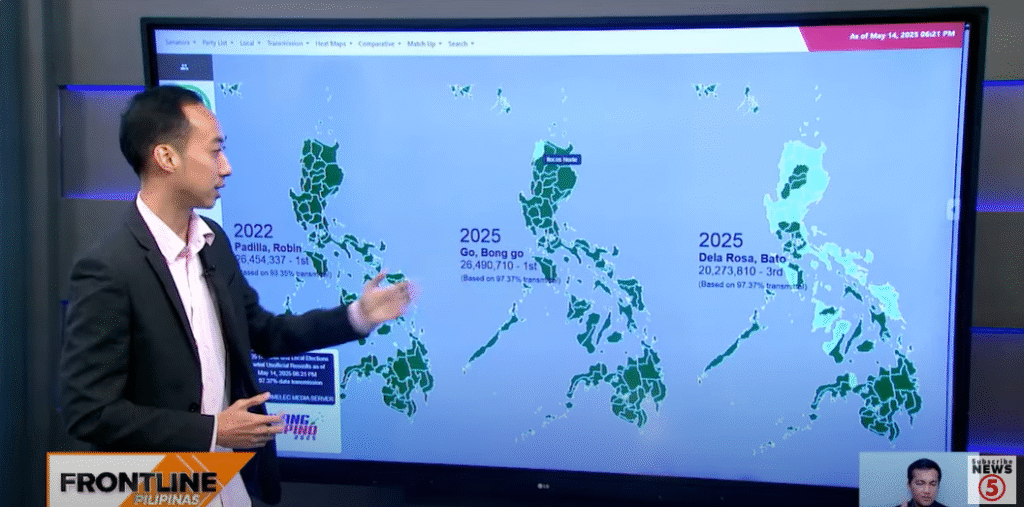
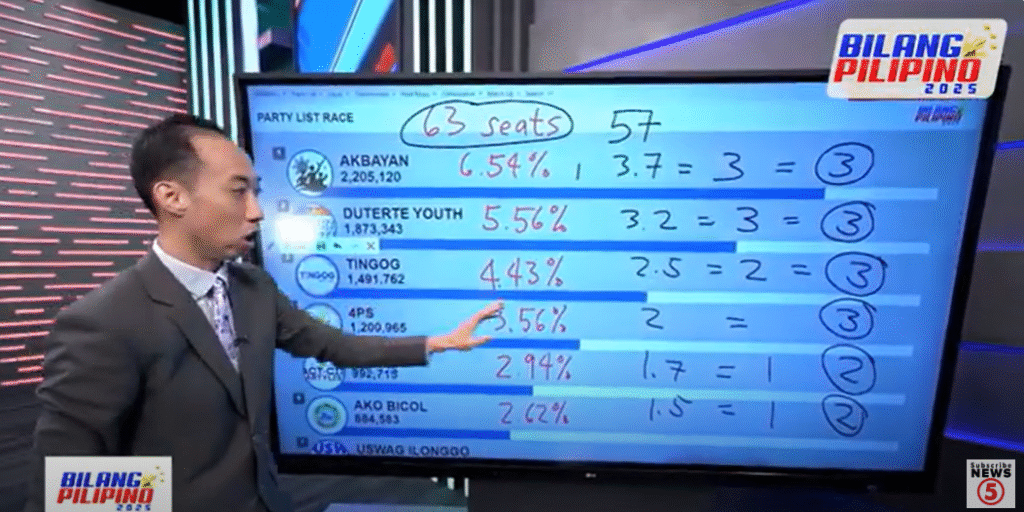
Guido identified the importance of the “Lingayen-Lucena corridor,” which holds 40 percent of votes, recalling the same corridor as key to securing Marcos Jr.’s presidency and crediting it for Bam Aquino’s successful run for the senate.
Guido went on to explain the math behind the party-list system, showing the computation that determines how many seats a party-list can secure. His analysis of “over-” and “under-performers,” as well as the pre-election surveys versus actual results, demonstrated the expanded view that data provides to the understanding of elections.
The 2025 election involves a demographic dimension. Media were not the only ones who missed the emergence of the youth vote. And yet, the data should have shown up their power early enough. Journalists in the country have yet to explore data as a source of stories. This field can enrich not just election coverage but governance in general. Journalism can play a role calling attention to cases of poor public service due to severe data gaps in public agencies.
Leave a Reply